Significance of Motivation in Hilton Hotels Employee Morale
VerifiedAdded on 2023/01/10
|28
|6596
|34
Report
AI Summary
This research project investigates the critical role of employee motivation in enhancing morale and productivity within Hilton Hotels. The introduction establishes the significance of motivation as an internal drive for employees to exert effort towards achieving organizational objectives, particularly within a global hospitality brand like Hilton. The literature review explores the importance of motivation, its impact on productivity, organizational efficiency, and workforce responsiveness, while also acknowledging the challenges faced by organizations in fostering employee morale, such as unclear expectations, inadequate resources, and lack of rewards. The study delves into various motivational theories, including Herzberg's Two-Factor Theory and goal-setting theory, and recommends corrective measures to address challenges and cultivate a motivated work environment, such as developing reward systems, managing conflicts, and promoting fairness. The methodology outlines the approach used to assess the key aspects of the study. The main body and findings section presents the core analysis, and the conclusion summarizes the key insights and provides recommendations based on the research findings. This report provides valuable insights for leadership and management in the hospitality industry and serves as an essential resource for students studying leadership and organizational behavior.
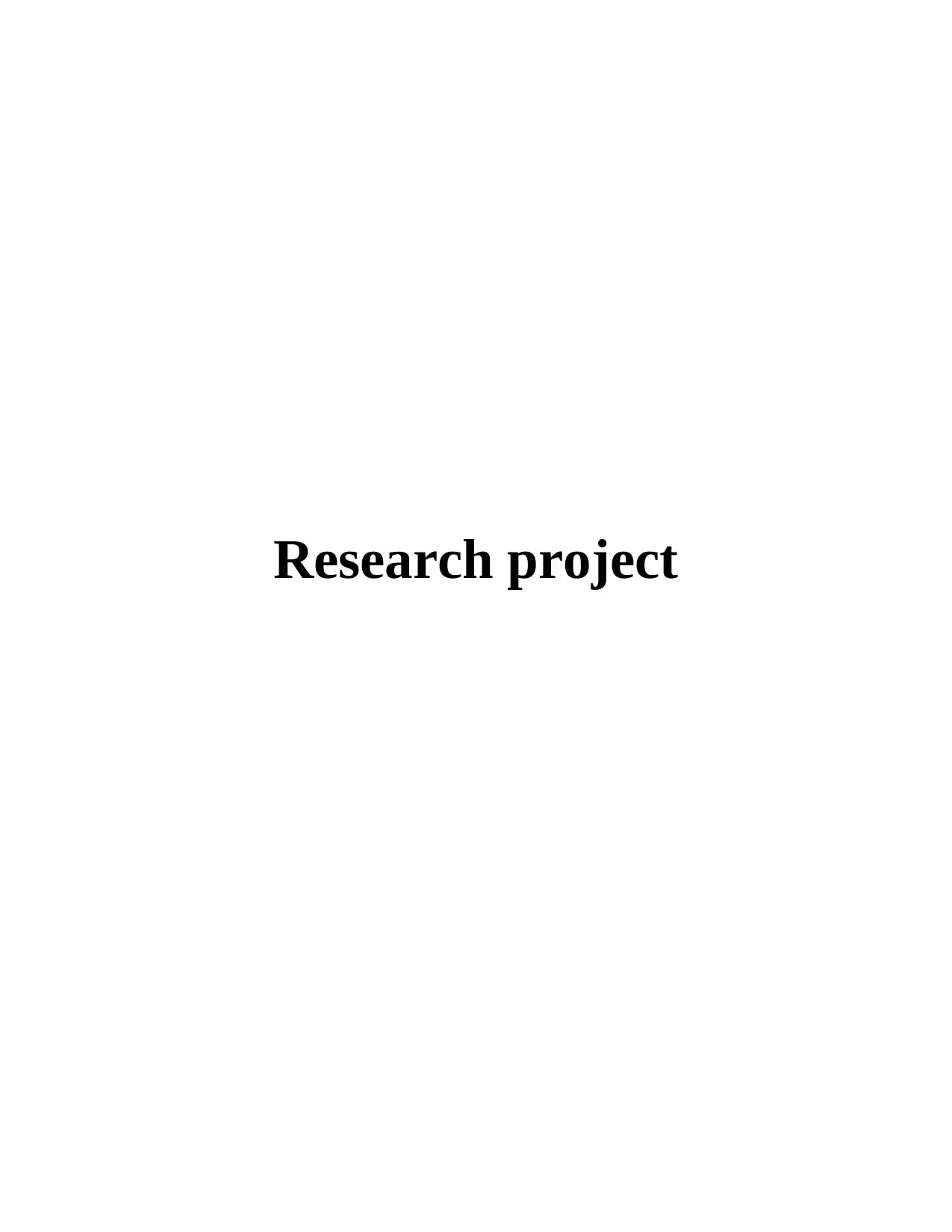
Research project
Paraphrase This Document
Need a fresh take? Get an instant paraphrase of this document with our AI Paraphraser
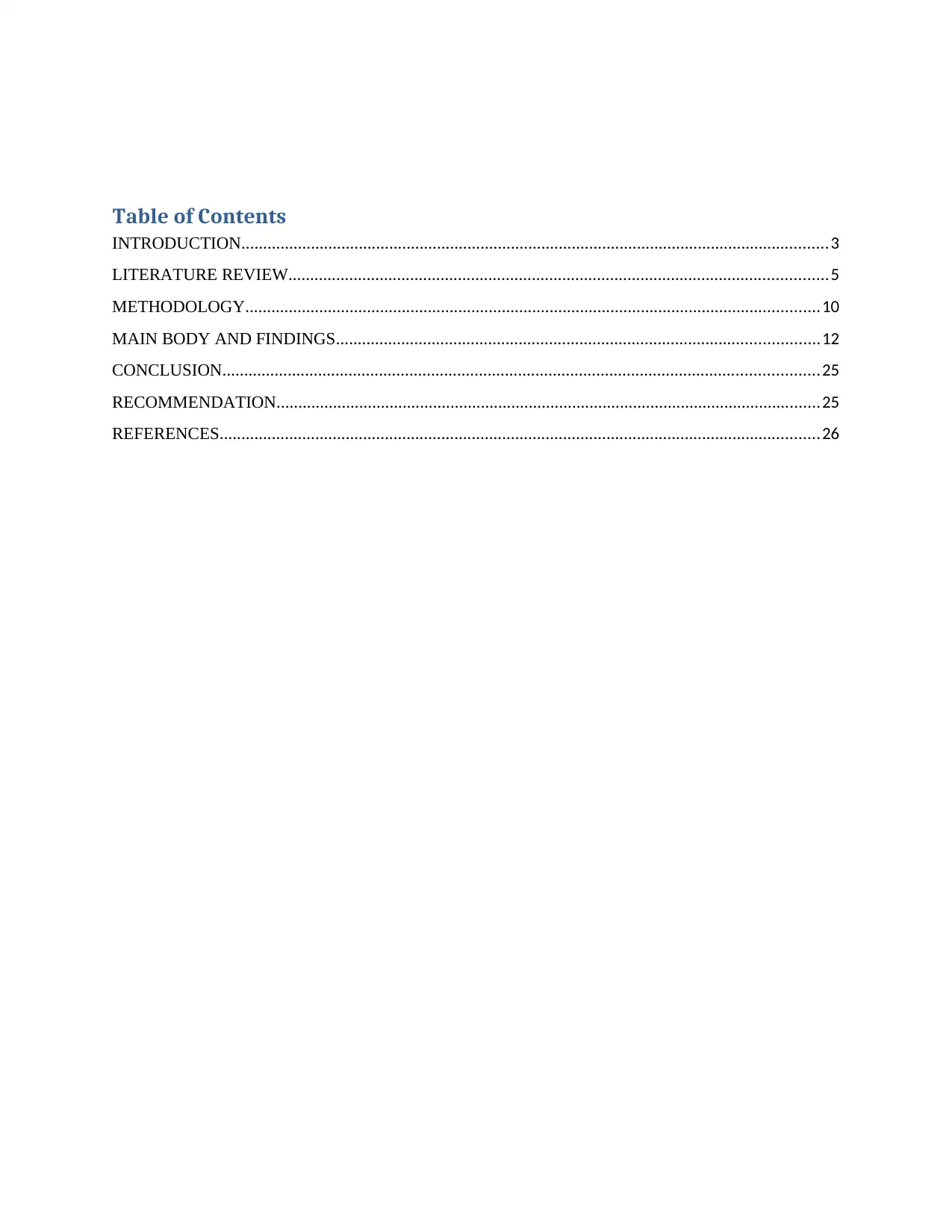
Table of Contents
INTRODUCTION.......................................................................................................................................3
LITERATURE REVIEW............................................................................................................................5
METHODOLOGY....................................................................................................................................10
MAIN BODY AND FINDINGS...............................................................................................................12
CONCLUSION.........................................................................................................................................25
RECOMMENDATION.............................................................................................................................25
REFERENCES..........................................................................................................................................26
INTRODUCTION.......................................................................................................................................3
LITERATURE REVIEW............................................................................................................................5
METHODOLOGY....................................................................................................................................10
MAIN BODY AND FINDINGS...............................................................................................................12
CONCLUSION.........................................................................................................................................25
RECOMMENDATION.............................................................................................................................25
REFERENCES..........................................................................................................................................26
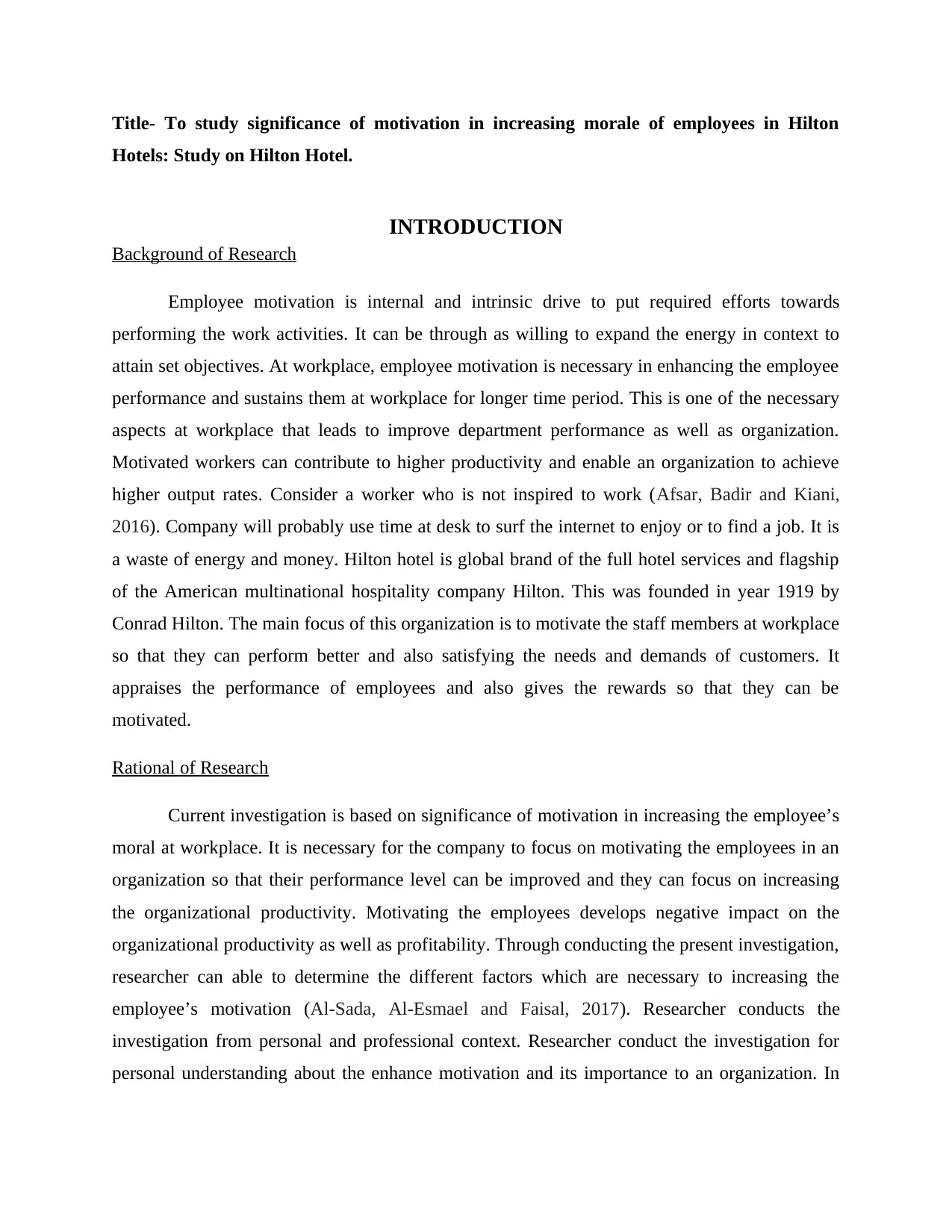
Title- To study significance of motivation in increasing morale of employees in Hilton
Hotels: Study on Hilton Hotel.
INTRODUCTION
Background of Research
Employee motivation is internal and intrinsic drive to put required efforts towards
performing the work activities. It can be through as willing to expand the energy in context to
attain set objectives. At workplace, employee motivation is necessary in enhancing the employee
performance and sustains them at workplace for longer time period. This is one of the necessary
aspects at workplace that leads to improve department performance as well as organization.
Motivated workers can contribute to higher productivity and enable an organization to achieve
higher output rates. Consider a worker who is not inspired to work (Afsar, Badir and Kiani,
2016). Company will probably use time at desk to surf the internet to enjoy or to find a job. It is
a waste of energy and money. Hilton hotel is global brand of the full hotel services and flagship
of the American multinational hospitality company Hilton. This was founded in year 1919 by
Conrad Hilton. The main focus of this organization is to motivate the staff members at workplace
so that they can perform better and also satisfying the needs and demands of customers. It
appraises the performance of employees and also gives the rewards so that they can be
motivated.
Rational of Research
Current investigation is based on significance of motivation in increasing the employee’s
moral at workplace. It is necessary for the company to focus on motivating the employees in an
organization so that their performance level can be improved and they can focus on increasing
the organizational productivity. Motivating the employees develops negative impact on the
organizational productivity as well as profitability. Through conducting the present investigation,
researcher can able to determine the different factors which are necessary to increasing the
employee’s motivation (Al-Sada, Al-Esmael and Faisal, 2017). Researcher conducts the
investigation from personal and professional context. Researcher conduct the investigation for
personal understanding about the enhance motivation and its importance to an organization. In
Hotels: Study on Hilton Hotel.
INTRODUCTION
Background of Research
Employee motivation is internal and intrinsic drive to put required efforts towards
performing the work activities. It can be through as willing to expand the energy in context to
attain set objectives. At workplace, employee motivation is necessary in enhancing the employee
performance and sustains them at workplace for longer time period. This is one of the necessary
aspects at workplace that leads to improve department performance as well as organization.
Motivated workers can contribute to higher productivity and enable an organization to achieve
higher output rates. Consider a worker who is not inspired to work (Afsar, Badir and Kiani,
2016). Company will probably use time at desk to surf the internet to enjoy or to find a job. It is
a waste of energy and money. Hilton hotel is global brand of the full hotel services and flagship
of the American multinational hospitality company Hilton. This was founded in year 1919 by
Conrad Hilton. The main focus of this organization is to motivate the staff members at workplace
so that they can perform better and also satisfying the needs and demands of customers. It
appraises the performance of employees and also gives the rewards so that they can be
motivated.
Rational of Research
Current investigation is based on significance of motivation in increasing the employee’s
moral at workplace. It is necessary for the company to focus on motivating the employees in an
organization so that their performance level can be improved and they can focus on increasing
the organizational productivity. Motivating the employees develops negative impact on the
organizational productivity as well as profitability. Through conducting the present investigation,
researcher can able to determine the different factors which are necessary to increasing the
employee’s motivation (Al-Sada, Al-Esmael and Faisal, 2017). Researcher conducts the
investigation from personal and professional context. Researcher conduct the investigation for
personal understanding about the enhance motivation and its importance to an organization. In
⊘ This is a preview!⊘
Do you want full access?
Subscribe today to unlock all pages.

Trusted by 1+ million students worldwide
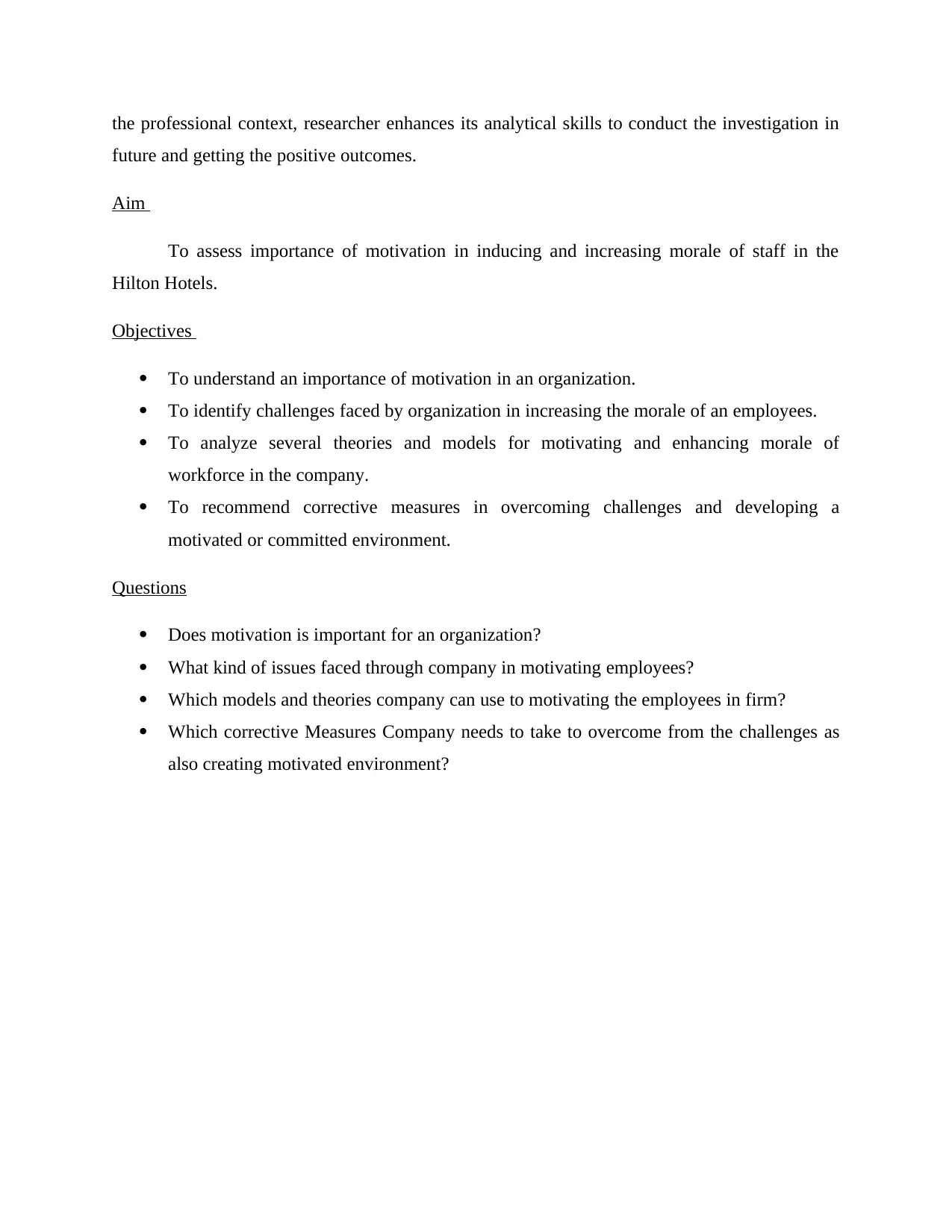
the professional context, researcher enhances its analytical skills to conduct the investigation in
future and getting the positive outcomes.
Aim
To assess importance of motivation in inducing and increasing morale of staff in the
Hilton Hotels.
Objectives
To understand an importance of motivation in an organization.
To identify challenges faced by organization in increasing the morale of an employees.
To analyze several theories and models for motivating and enhancing morale of
workforce in the company.
To recommend corrective measures in overcoming challenges and developing a
motivated or committed environment.
Questions
Does motivation is important for an organization?
What kind of issues faced through company in motivating employees?
Which models and theories company can use to motivating the employees in firm?
Which corrective Measures Company needs to take to overcome from the challenges as
also creating motivated environment?
future and getting the positive outcomes.
Aim
To assess importance of motivation in inducing and increasing morale of staff in the
Hilton Hotels.
Objectives
To understand an importance of motivation in an organization.
To identify challenges faced by organization in increasing the morale of an employees.
To analyze several theories and models for motivating and enhancing morale of
workforce in the company.
To recommend corrective measures in overcoming challenges and developing a
motivated or committed environment.
Questions
Does motivation is important for an organization?
What kind of issues faced through company in motivating employees?
Which models and theories company can use to motivating the employees in firm?
Which corrective Measures Company needs to take to overcome from the challenges as
also creating motivated environment?
Paraphrase This Document
Need a fresh take? Get an instant paraphrase of this document with our AI Paraphraser
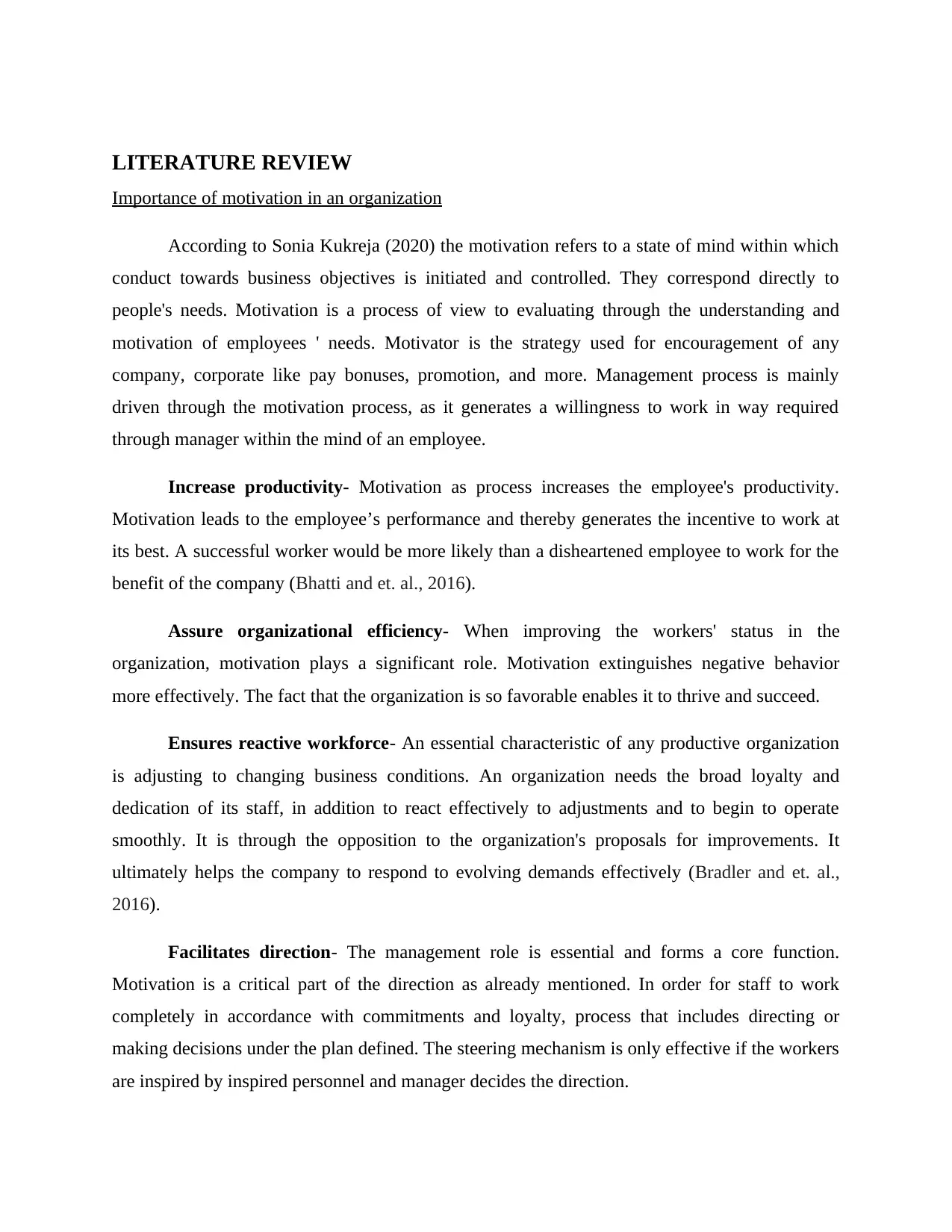
LITERATURE REVIEW
Importance of motivation in an organization
According to Sonia Kukreja (2020) the motivation refers to a state of mind within which
conduct towards business objectives is initiated and controlled. They correspond directly to
people's needs. Motivation is a process of view to evaluating through the understanding and
motivation of employees ' needs. Motivator is the strategy used for encouragement of any
company, corporate like pay bonuses, promotion, and more. Management process is mainly
driven through the motivation process, as it generates a willingness to work in way required
through manager within the mind of an employee.
Increase productivity- Motivation as process increases the employee's productivity.
Motivation leads to the employee’s performance and thereby generates the incentive to work at
its best. A successful worker would be more likely than a disheartened employee to work for the
benefit of the company (Bhatti and et. al., 2016).
Assure organizational efficiency- When improving the workers' status in the
organization, motivation plays a significant role. Motivation extinguishes negative behavior
more effectively. The fact that the organization is so favorable enables it to thrive and succeed.
Ensures reactive workforce- An essential characteristic of any productive organization
is adjusting to changing business conditions. An organization needs the broad loyalty and
dedication of its staff, in addition to react effectively to adjustments and to begin to operate
smoothly. It is through the opposition to the organization's proposals for improvements. It
ultimately helps the company to respond to evolving demands effectively (Bradler and et. al.,
2016).
Facilitates direction- The management role is essential and forms a core function.
Motivation is a critical part of the direction as already mentioned. In order for staff to work
completely in accordance with commitments and loyalty, process that includes directing or
making decisions under the plan defined. The steering mechanism is only effective if the workers
are inspired by inspired personnel and manager decides the direction.
Importance of motivation in an organization
According to Sonia Kukreja (2020) the motivation refers to a state of mind within which
conduct towards business objectives is initiated and controlled. They correspond directly to
people's needs. Motivation is a process of view to evaluating through the understanding and
motivation of employees ' needs. Motivator is the strategy used for encouragement of any
company, corporate like pay bonuses, promotion, and more. Management process is mainly
driven through the motivation process, as it generates a willingness to work in way required
through manager within the mind of an employee.
Increase productivity- Motivation as process increases the employee's productivity.
Motivation leads to the employee’s performance and thereby generates the incentive to work at
its best. A successful worker would be more likely than a disheartened employee to work for the
benefit of the company (Bhatti and et. al., 2016).
Assure organizational efficiency- When improving the workers' status in the
organization, motivation plays a significant role. Motivation extinguishes negative behavior
more effectively. The fact that the organization is so favorable enables it to thrive and succeed.
Ensures reactive workforce- An essential characteristic of any productive organization
is adjusting to changing business conditions. An organization needs the broad loyalty and
dedication of its staff, in addition to react effectively to adjustments and to begin to operate
smoothly. It is through the opposition to the organization's proposals for improvements. It
ultimately helps the company to respond to evolving demands effectively (Bradler and et. al.,
2016).
Facilitates direction- The management role is essential and forms a core function.
Motivation is a critical part of the direction as already mentioned. In order for staff to work
completely in accordance with commitments and loyalty, process that includes directing or
making decisions under the plan defined. The steering mechanism is only effective if the workers
are inspired by inspired personnel and manager decides the direction.
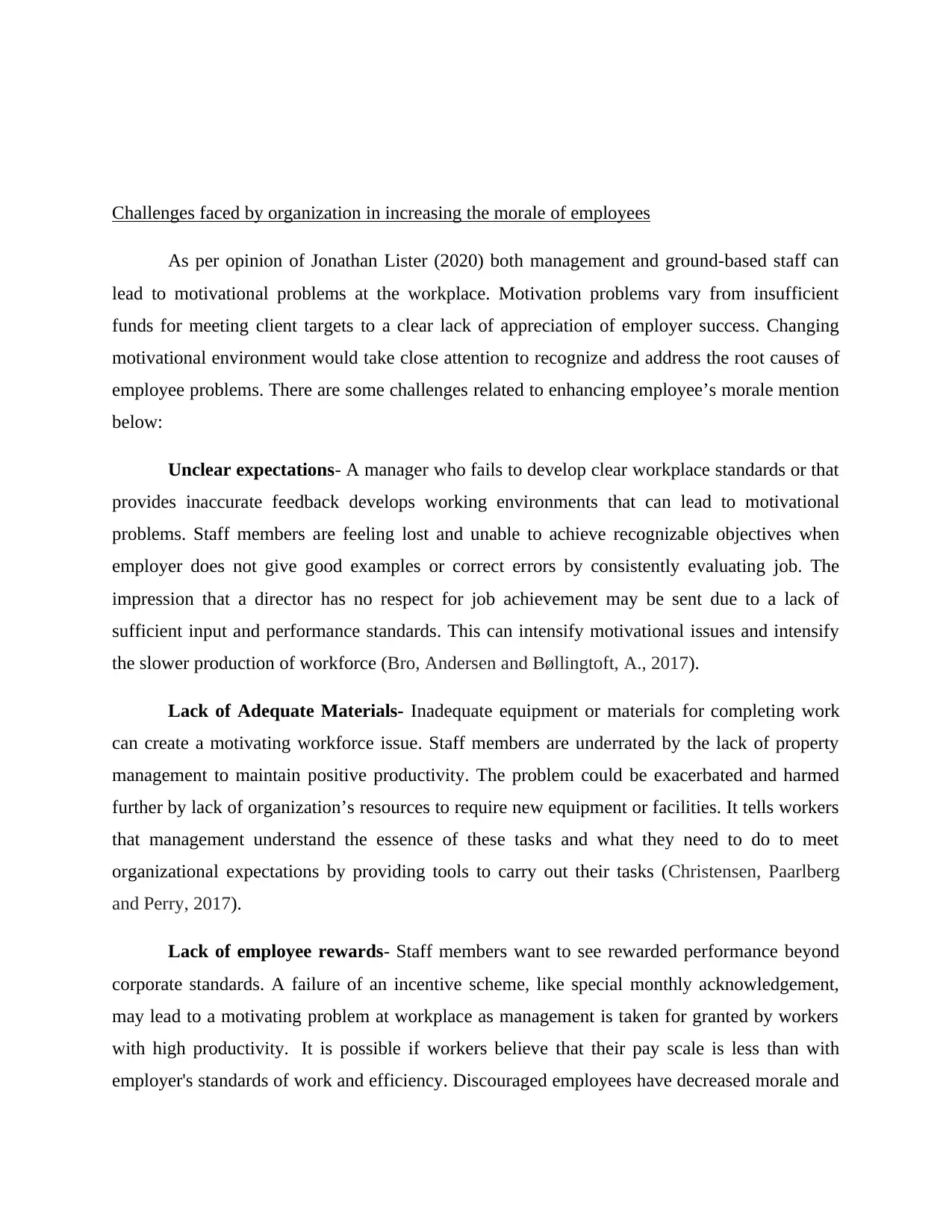
Challenges faced by organization in increasing the morale of employees
As per opinion of Jonathan Lister (2020) both management and ground-based staff can
lead to motivational problems at the workplace. Motivation problems vary from insufficient
funds for meeting client targets to a clear lack of appreciation of employer success. Changing
motivational environment would take close attention to recognize and address the root causes of
employee problems. There are some challenges related to enhancing employee’s morale mention
below:
Unclear expectations- A manager who fails to develop clear workplace standards or that
provides inaccurate feedback develops working environments that can lead to motivational
problems. Staff members are feeling lost and unable to achieve recognizable objectives when
employer does not give good examples or correct errors by consistently evaluating job. The
impression that a director has no respect for job achievement may be sent due to a lack of
sufficient input and performance standards. This can intensify motivational issues and intensify
the slower production of workforce (Bro, Andersen and Bøllingtoft, A., 2017).
Lack of Adequate Materials- Inadequate equipment or materials for completing work
can create a motivating workforce issue. Staff members are underrated by the lack of property
management to maintain positive productivity. The problem could be exacerbated and harmed
further by lack of organization’s resources to require new equipment or facilities. It tells workers
that management understand the essence of these tasks and what they need to do to meet
organizational expectations by providing tools to carry out their tasks (Christensen, Paarlberg
and Perry, 2017).
Lack of employee rewards- Staff members want to see rewarded performance beyond
corporate standards. A failure of an incentive scheme, like special monthly acknowledgement,
may lead to a motivating problem at workplace as management is taken for granted by workers
with high productivity. It is possible if workers believe that their pay scale is less than with
employer's standards of work and efficiency. Discouraged employees have decreased morale and
As per opinion of Jonathan Lister (2020) both management and ground-based staff can
lead to motivational problems at the workplace. Motivation problems vary from insufficient
funds for meeting client targets to a clear lack of appreciation of employer success. Changing
motivational environment would take close attention to recognize and address the root causes of
employee problems. There are some challenges related to enhancing employee’s morale mention
below:
Unclear expectations- A manager who fails to develop clear workplace standards or that
provides inaccurate feedback develops working environments that can lead to motivational
problems. Staff members are feeling lost and unable to achieve recognizable objectives when
employer does not give good examples or correct errors by consistently evaluating job. The
impression that a director has no respect for job achievement may be sent due to a lack of
sufficient input and performance standards. This can intensify motivational issues and intensify
the slower production of workforce (Bro, Andersen and Bøllingtoft, A., 2017).
Lack of Adequate Materials- Inadequate equipment or materials for completing work
can create a motivating workforce issue. Staff members are underrated by the lack of property
management to maintain positive productivity. The problem could be exacerbated and harmed
further by lack of organization’s resources to require new equipment or facilities. It tells workers
that management understand the essence of these tasks and what they need to do to meet
organizational expectations by providing tools to carry out their tasks (Christensen, Paarlberg
and Perry, 2017).
Lack of employee rewards- Staff members want to see rewarded performance beyond
corporate standards. A failure of an incentive scheme, like special monthly acknowledgement,
may lead to a motivating problem at workplace as management is taken for granted by workers
with high productivity. It is possible if workers believe that their pay scale is less than with
employer's standards of work and efficiency. Discouraged employees have decreased morale and
⊘ This is a preview!⊘
Do you want full access?
Subscribe today to unlock all pages.

Trusted by 1+ million students worldwide
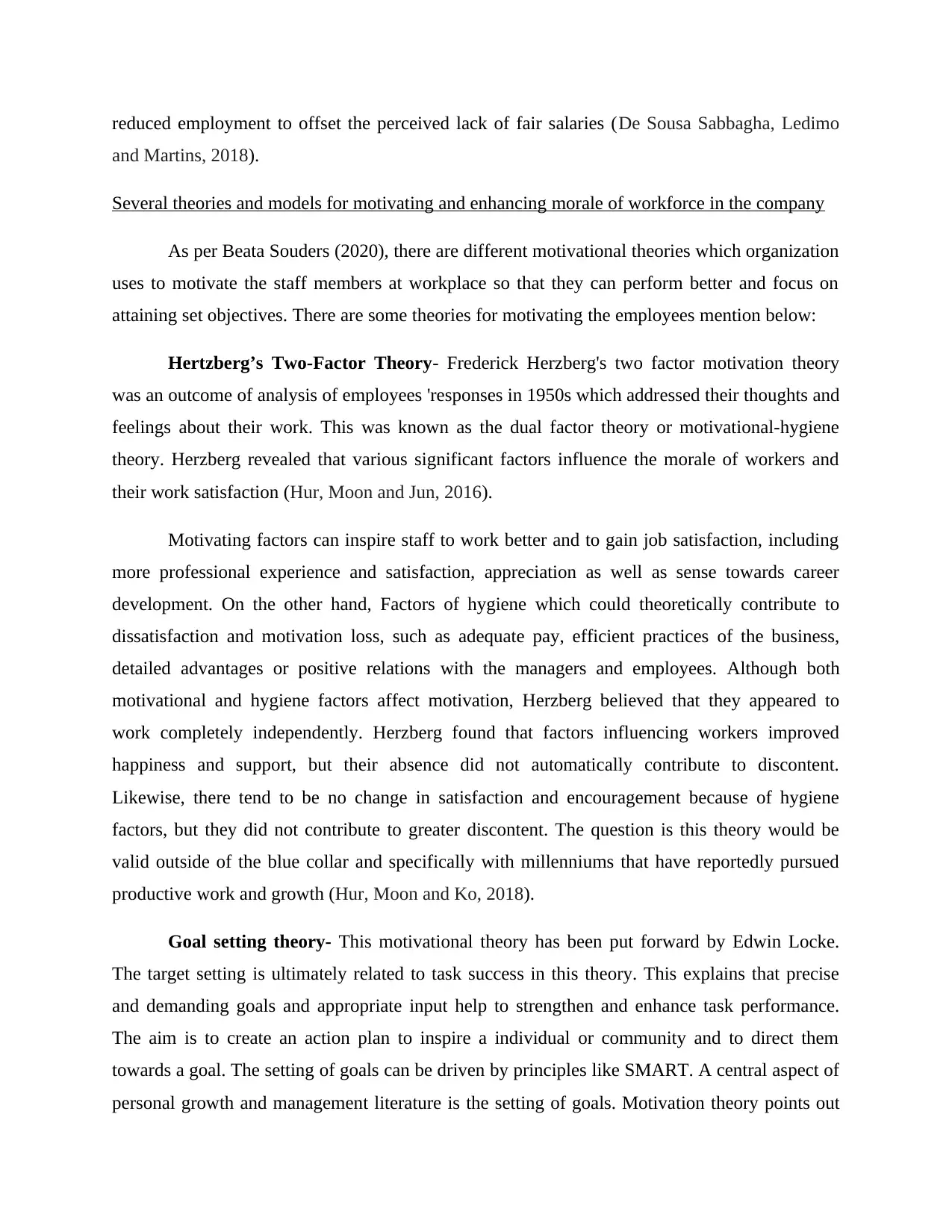
reduced employment to offset the perceived lack of fair salaries (De Sousa Sabbagha, Ledimo
and Martins, 2018).
Several theories and models for motivating and enhancing morale of workforce in the company
As per Beata Souders (2020), there are different motivational theories which organization
uses to motivate the staff members at workplace so that they can perform better and focus on
attaining set objectives. There are some theories for motivating the employees mention below:
Hertzberg’s Two-Factor Theory- Frederick Herzberg's two factor motivation theory
was an outcome of analysis of employees 'responses in 1950s which addressed their thoughts and
feelings about their work. This was known as the dual factor theory or motivational-hygiene
theory. Herzberg revealed that various significant factors influence the morale of workers and
their work satisfaction (Hur, Moon and Jun, 2016).
Motivating factors can inspire staff to work better and to gain job satisfaction, including
more professional experience and satisfaction, appreciation as well as sense towards career
development. On the other hand, Factors of hygiene which could theoretically contribute to
dissatisfaction and motivation loss, such as adequate pay, efficient practices of the business,
detailed advantages or positive relations with the managers and employees. Although both
motivational and hygiene factors affect motivation, Herzberg believed that they appeared to
work completely independently. Herzberg found that factors influencing workers improved
happiness and support, but their absence did not automatically contribute to discontent.
Likewise, there tend to be no change in satisfaction and encouragement because of hygiene
factors, but they did not contribute to greater discontent. The question is this theory would be
valid outside of the blue collar and specifically with millenniums that have reportedly pursued
productive work and growth (Hur, Moon and Ko, 2018).
Goal setting theory- This motivational theory has been put forward by Edwin Locke.
The target setting is ultimately related to task success in this theory. This explains that precise
and demanding goals and appropriate input help to strengthen and enhance task performance.
The aim is to create an action plan to inspire a individual or community and to direct them
towards a goal. The setting of goals can be driven by principles like SMART. A central aspect of
personal growth and management literature is the setting of goals. Motivation theory points out
and Martins, 2018).
Several theories and models for motivating and enhancing morale of workforce in the company
As per Beata Souders (2020), there are different motivational theories which organization
uses to motivate the staff members at workplace so that they can perform better and focus on
attaining set objectives. There are some theories for motivating the employees mention below:
Hertzberg’s Two-Factor Theory- Frederick Herzberg's two factor motivation theory
was an outcome of analysis of employees 'responses in 1950s which addressed their thoughts and
feelings about their work. This was known as the dual factor theory or motivational-hygiene
theory. Herzberg revealed that various significant factors influence the morale of workers and
their work satisfaction (Hur, Moon and Jun, 2016).
Motivating factors can inspire staff to work better and to gain job satisfaction, including
more professional experience and satisfaction, appreciation as well as sense towards career
development. On the other hand, Factors of hygiene which could theoretically contribute to
dissatisfaction and motivation loss, such as adequate pay, efficient practices of the business,
detailed advantages or positive relations with the managers and employees. Although both
motivational and hygiene factors affect motivation, Herzberg believed that they appeared to
work completely independently. Herzberg found that factors influencing workers improved
happiness and support, but their absence did not automatically contribute to discontent.
Likewise, there tend to be no change in satisfaction and encouragement because of hygiene
factors, but they did not contribute to greater discontent. The question is this theory would be
valid outside of the blue collar and specifically with millenniums that have reportedly pursued
productive work and growth (Hur, Moon and Ko, 2018).
Goal setting theory- This motivational theory has been put forward by Edwin Locke.
The target setting is ultimately related to task success in this theory. This explains that precise
and demanding goals and appropriate input help to strengthen and enhance task performance.
The aim is to create an action plan to inspire a individual or community and to direct them
towards a goal. The setting of goals can be driven by principles like SMART. A central aspect of
personal growth and management literature is the setting of goals. Motivation theory points out
Paraphrase This Document
Need a fresh take? Get an instant paraphrase of this document with our AI Paraphraser
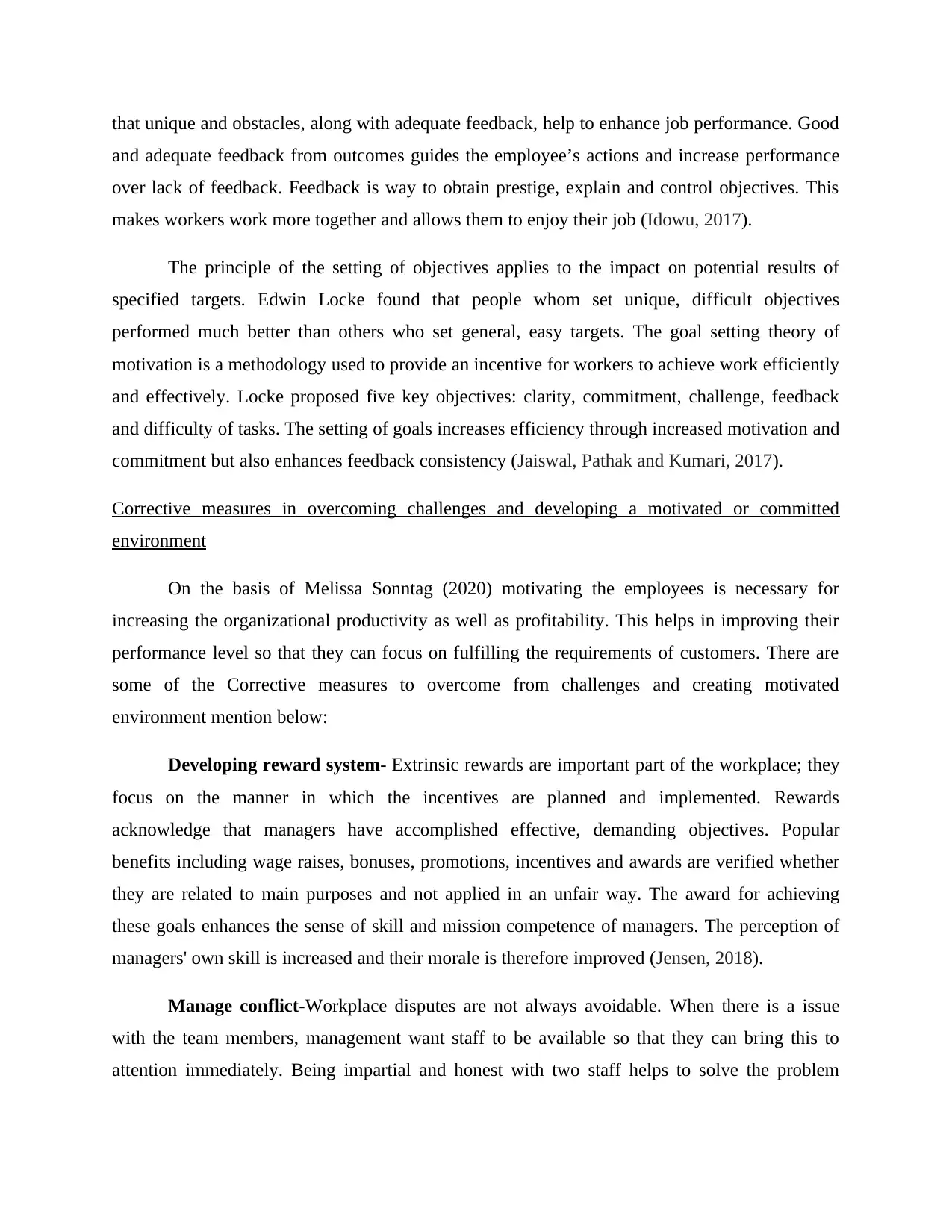
that unique and obstacles, along with adequate feedback, help to enhance job performance. Good
and adequate feedback from outcomes guides the employee’s actions and increase performance
over lack of feedback. Feedback is way to obtain prestige, explain and control objectives. This
makes workers work more together and allows them to enjoy their job (Idowu, 2017).
The principle of the setting of objectives applies to the impact on potential results of
specified targets. Edwin Locke found that people whom set unique, difficult objectives
performed much better than others who set general, easy targets. The goal setting theory of
motivation is a methodology used to provide an incentive for workers to achieve work efficiently
and effectively. Locke proposed five key objectives: clarity, commitment, challenge, feedback
and difficulty of tasks. The setting of goals increases efficiency through increased motivation and
commitment but also enhances feedback consistency (Jaiswal, Pathak and Kumari, 2017).
Corrective measures in overcoming challenges and developing a motivated or committed
environment
On the basis of Melissa Sonntag (2020) motivating the employees is necessary for
increasing the organizational productivity as well as profitability. This helps in improving their
performance level so that they can focus on fulfilling the requirements of customers. There are
some of the Corrective measures to overcome from challenges and creating motivated
environment mention below:
Developing reward system- Extrinsic rewards are important part of the workplace; they
focus on the manner in which the incentives are planned and implemented. Rewards
acknowledge that managers have accomplished effective, demanding objectives. Popular
benefits including wage raises, bonuses, promotions, incentives and awards are verified whether
they are related to main purposes and not applied in an unfair way. The award for achieving
these goals enhances the sense of skill and mission competence of managers. The perception of
managers' own skill is increased and their morale is therefore improved (Jensen, 2018).
Manage conflict-Workplace disputes are not always avoidable. When there is a issue
with the team members, management want staff to be available so that they can bring this to
attention immediately. Being impartial and honest with two staff helps to solve the problem
and adequate feedback from outcomes guides the employee’s actions and increase performance
over lack of feedback. Feedback is way to obtain prestige, explain and control objectives. This
makes workers work more together and allows them to enjoy their job (Idowu, 2017).
The principle of the setting of objectives applies to the impact on potential results of
specified targets. Edwin Locke found that people whom set unique, difficult objectives
performed much better than others who set general, easy targets. The goal setting theory of
motivation is a methodology used to provide an incentive for workers to achieve work efficiently
and effectively. Locke proposed five key objectives: clarity, commitment, challenge, feedback
and difficulty of tasks. The setting of goals increases efficiency through increased motivation and
commitment but also enhances feedback consistency (Jaiswal, Pathak and Kumari, 2017).
Corrective measures in overcoming challenges and developing a motivated or committed
environment
On the basis of Melissa Sonntag (2020) motivating the employees is necessary for
increasing the organizational productivity as well as profitability. This helps in improving their
performance level so that they can focus on fulfilling the requirements of customers. There are
some of the Corrective measures to overcome from challenges and creating motivated
environment mention below:
Developing reward system- Extrinsic rewards are important part of the workplace; they
focus on the manner in which the incentives are planned and implemented. Rewards
acknowledge that managers have accomplished effective, demanding objectives. Popular
benefits including wage raises, bonuses, promotions, incentives and awards are verified whether
they are related to main purposes and not applied in an unfair way. The award for achieving
these goals enhances the sense of skill and mission competence of managers. The perception of
managers' own skill is increased and their morale is therefore improved (Jensen, 2018).
Manage conflict-Workplace disputes are not always avoidable. When there is a issue
with the team members, management want staff to be available so that they can bring this to
attention immediately. Being impartial and honest with two staff helps to solve the problem
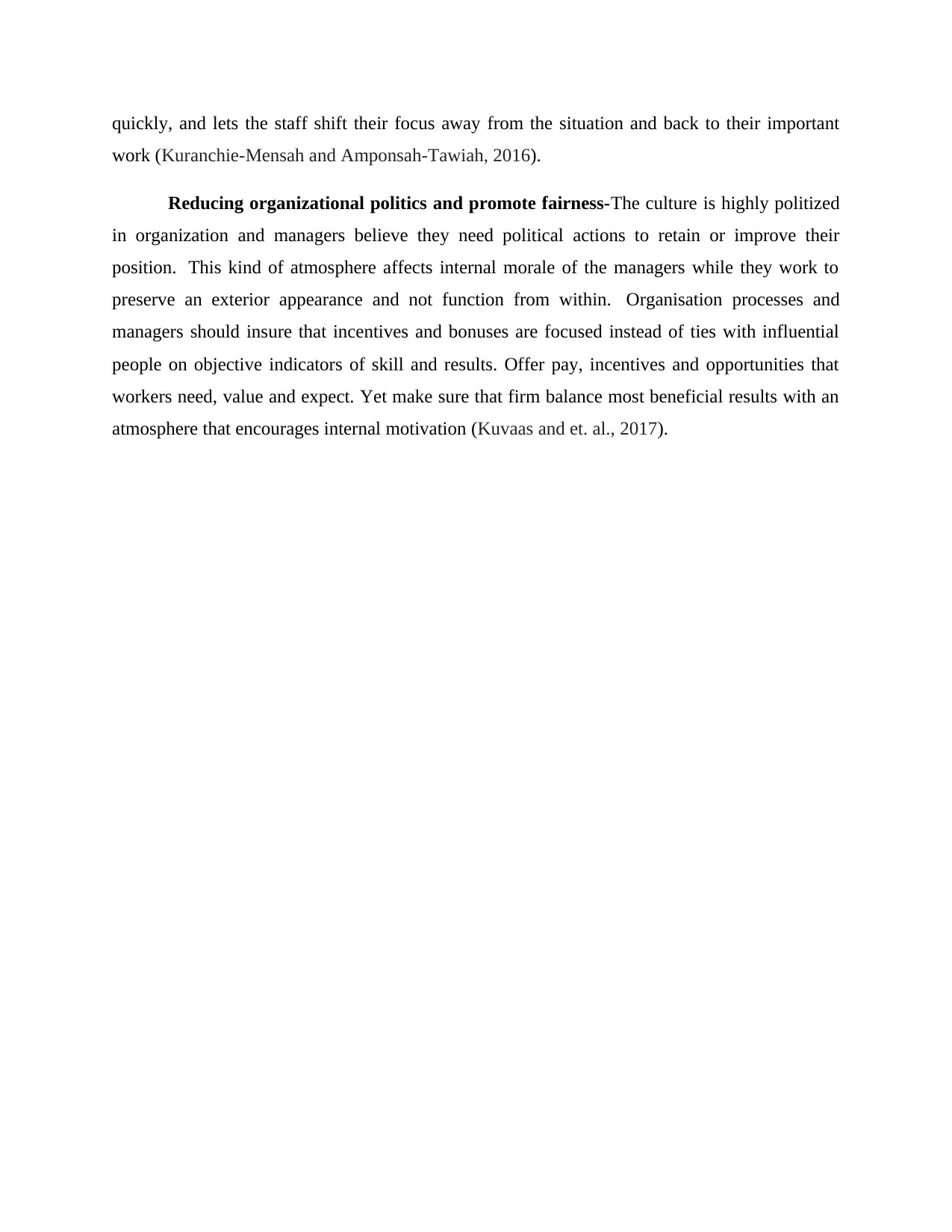
quickly, and lets the staff shift their focus away from the situation and back to their important
work (Kuranchie-Mensah and Amponsah-Tawiah, 2016).
Reducing organizational politics and promote fairness-The culture is highly politized
in organization and managers believe they need political actions to retain or improve their
position. This kind of atmosphere affects internal morale of the managers while they work to
preserve an exterior appearance and not function from within. Organisation processes and
managers should insure that incentives and bonuses are focused instead of ties with influential
people on objective indicators of skill and results. Offer pay, incentives and opportunities that
workers need, value and expect. Yet make sure that firm balance most beneficial results with an
atmosphere that encourages internal motivation (Kuvaas and et. al., 2017).
work (Kuranchie-Mensah and Amponsah-Tawiah, 2016).
Reducing organizational politics and promote fairness-The culture is highly politized
in organization and managers believe they need political actions to retain or improve their
position. This kind of atmosphere affects internal morale of the managers while they work to
preserve an exterior appearance and not function from within. Organisation processes and
managers should insure that incentives and bonuses are focused instead of ties with influential
people on objective indicators of skill and results. Offer pay, incentives and opportunities that
workers need, value and expect. Yet make sure that firm balance most beneficial results with an
atmosphere that encourages internal motivation (Kuvaas and et. al., 2017).
⊘ This is a preview!⊘
Do you want full access?
Subscribe today to unlock all pages.

Trusted by 1+ million students worldwide
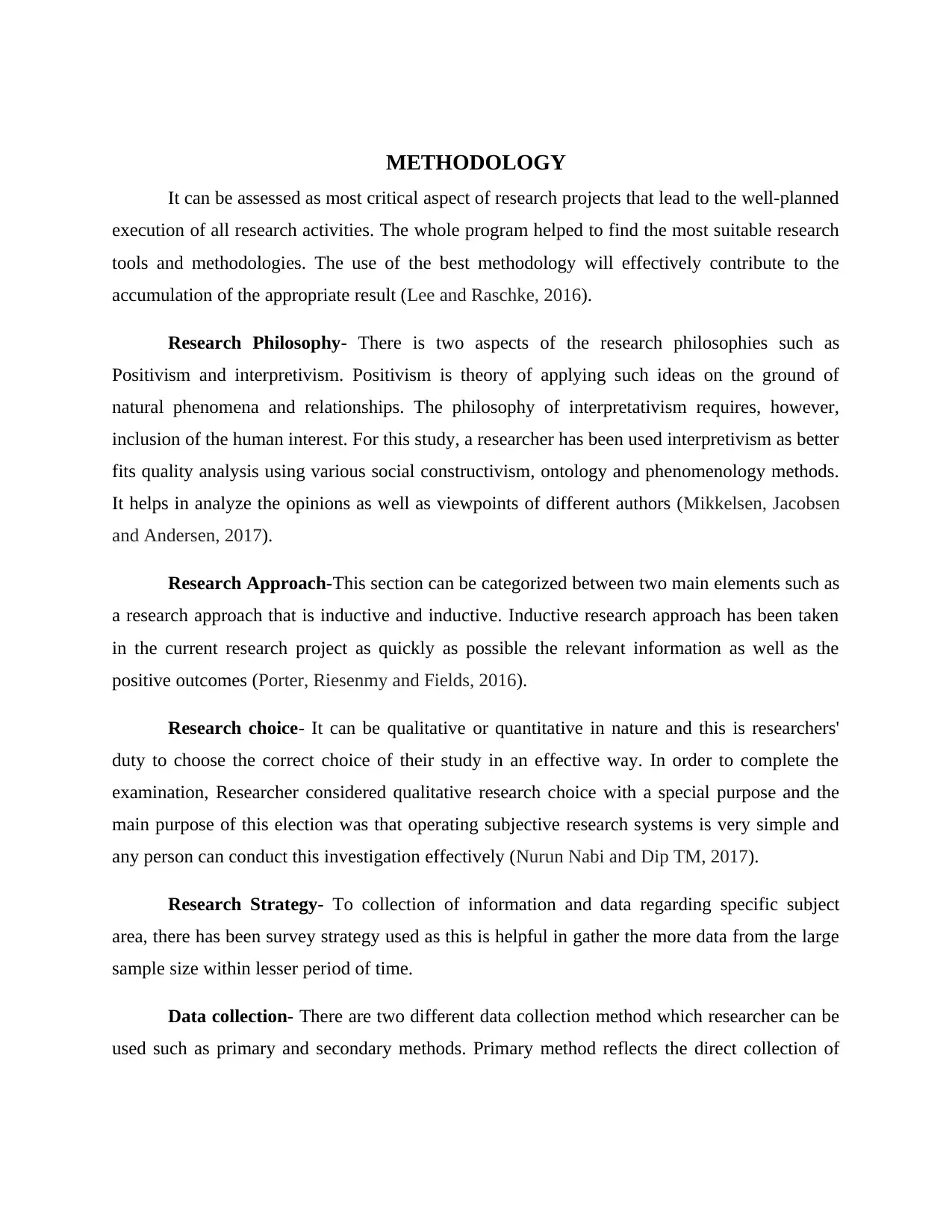
METHODOLOGY
It can be assessed as most critical aspect of research projects that lead to the well-planned
execution of all research activities. The whole program helped to find the most suitable research
tools and methodologies. The use of the best methodology will effectively contribute to the
accumulation of the appropriate result (Lee and Raschke, 2016).
Research Philosophy- There is two aspects of the research philosophies such as
Positivism and interpretivism. Positivism is theory of applying such ideas on the ground of
natural phenomena and relationships. The philosophy of interpretativism requires, however,
inclusion of the human interest. For this study, a researcher has been used interpretivism as better
fits quality analysis using various social constructivism, ontology and phenomenology methods.
It helps in analyze the opinions as well as viewpoints of different authors (Mikkelsen, Jacobsen
and Andersen, 2017).
Research Approach-This section can be categorized between two main elements such as
a research approach that is inductive and inductive. Inductive research approach has been taken
in the current research project as quickly as possible the relevant information as well as the
positive outcomes (Porter, Riesenmy and Fields, 2016).
Research choice- It can be qualitative or quantitative in nature and this is researchers'
duty to choose the correct choice of their study in an effective way. In order to complete the
examination, Researcher considered qualitative research choice with a special purpose and the
main purpose of this election was that operating subjective research systems is very simple and
any person can conduct this investigation effectively (Nurun Nabi and Dip TM, 2017).
Research Strategy- To collection of information and data regarding specific subject
area, there has been survey strategy used as this is helpful in gather the more data from the large
sample size within lesser period of time.
Data collection- There are two different data collection method which researcher can be
used such as primary and secondary methods. Primary method reflects the direct collection of
It can be assessed as most critical aspect of research projects that lead to the well-planned
execution of all research activities. The whole program helped to find the most suitable research
tools and methodologies. The use of the best methodology will effectively contribute to the
accumulation of the appropriate result (Lee and Raschke, 2016).
Research Philosophy- There is two aspects of the research philosophies such as
Positivism and interpretivism. Positivism is theory of applying such ideas on the ground of
natural phenomena and relationships. The philosophy of interpretativism requires, however,
inclusion of the human interest. For this study, a researcher has been used interpretivism as better
fits quality analysis using various social constructivism, ontology and phenomenology methods.
It helps in analyze the opinions as well as viewpoints of different authors (Mikkelsen, Jacobsen
and Andersen, 2017).
Research Approach-This section can be categorized between two main elements such as
a research approach that is inductive and inductive. Inductive research approach has been taken
in the current research project as quickly as possible the relevant information as well as the
positive outcomes (Porter, Riesenmy and Fields, 2016).
Research choice- It can be qualitative or quantitative in nature and this is researchers'
duty to choose the correct choice of their study in an effective way. In order to complete the
examination, Researcher considered qualitative research choice with a special purpose and the
main purpose of this election was that operating subjective research systems is very simple and
any person can conduct this investigation effectively (Nurun Nabi and Dip TM, 2017).
Research Strategy- To collection of information and data regarding specific subject
area, there has been survey strategy used as this is helpful in gather the more data from the large
sample size within lesser period of time.
Data collection- There are two different data collection method which researcher can be
used such as primary and secondary methods. Primary method reflects the direct collection of
Paraphrase This Document
Need a fresh take? Get an instant paraphrase of this document with our AI Paraphraser
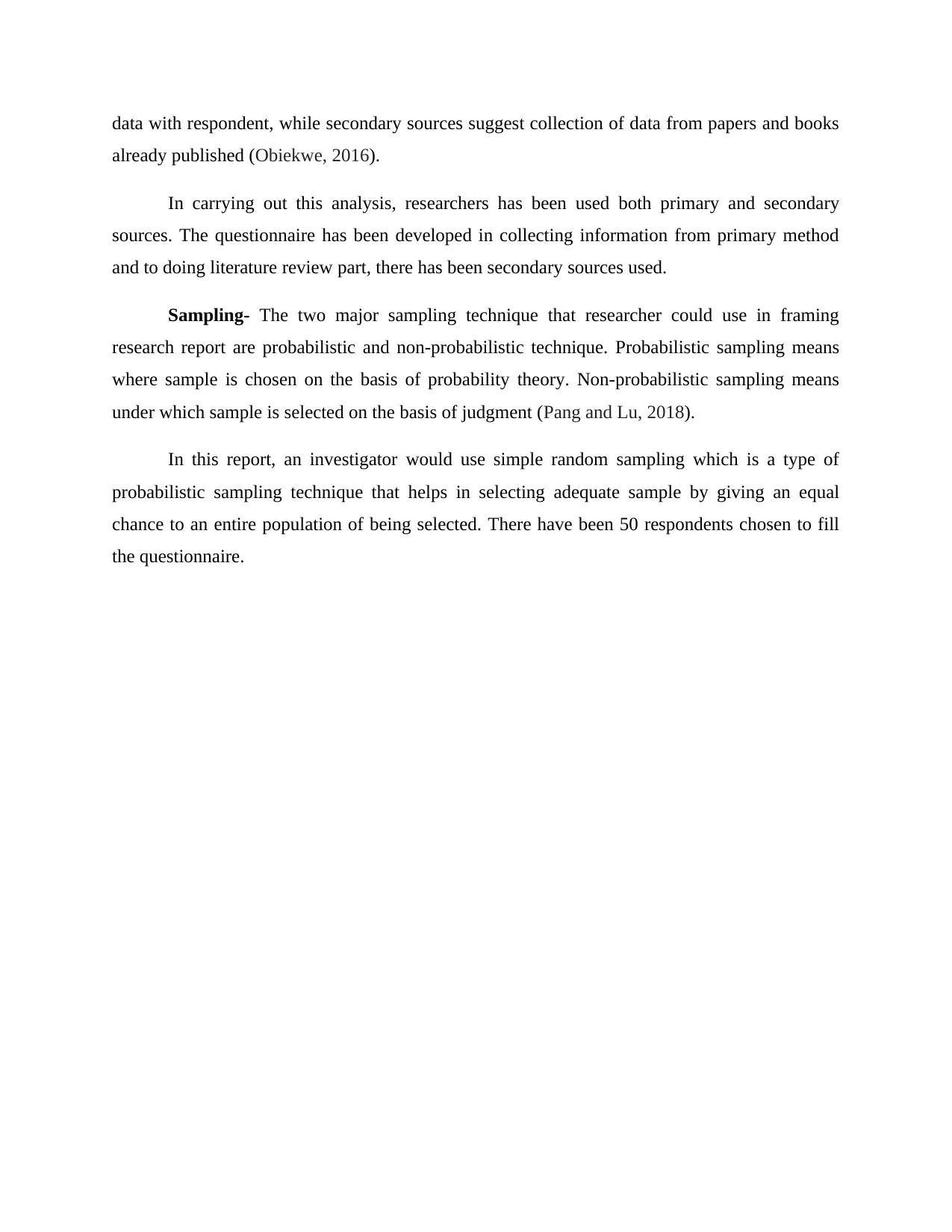
data with respondent, while secondary sources suggest collection of data from papers and books
already published (Obiekwe, 2016).
In carrying out this analysis, researchers has been used both primary and secondary
sources. The questionnaire has been developed in collecting information from primary method
and to doing literature review part, there has been secondary sources used.
Sampling- The two major sampling technique that researcher could use in framing
research report are probabilistic and non-probabilistic technique. Probabilistic sampling means
where sample is chosen on the basis of probability theory. Non-probabilistic sampling means
under which sample is selected on the basis of judgment (Pang and Lu, 2018).
In this report, an investigator would use simple random sampling which is a type of
probabilistic sampling technique that helps in selecting adequate sample by giving an equal
chance to an entire population of being selected. There have been 50 respondents chosen to fill
the questionnaire.
already published (Obiekwe, 2016).
In carrying out this analysis, researchers has been used both primary and secondary
sources. The questionnaire has been developed in collecting information from primary method
and to doing literature review part, there has been secondary sources used.
Sampling- The two major sampling technique that researcher could use in framing
research report are probabilistic and non-probabilistic technique. Probabilistic sampling means
where sample is chosen on the basis of probability theory. Non-probabilistic sampling means
under which sample is selected on the basis of judgment (Pang and Lu, 2018).
In this report, an investigator would use simple random sampling which is a type of
probabilistic sampling technique that helps in selecting adequate sample by giving an equal
chance to an entire population of being selected. There have been 50 respondents chosen to fill
the questionnaire.
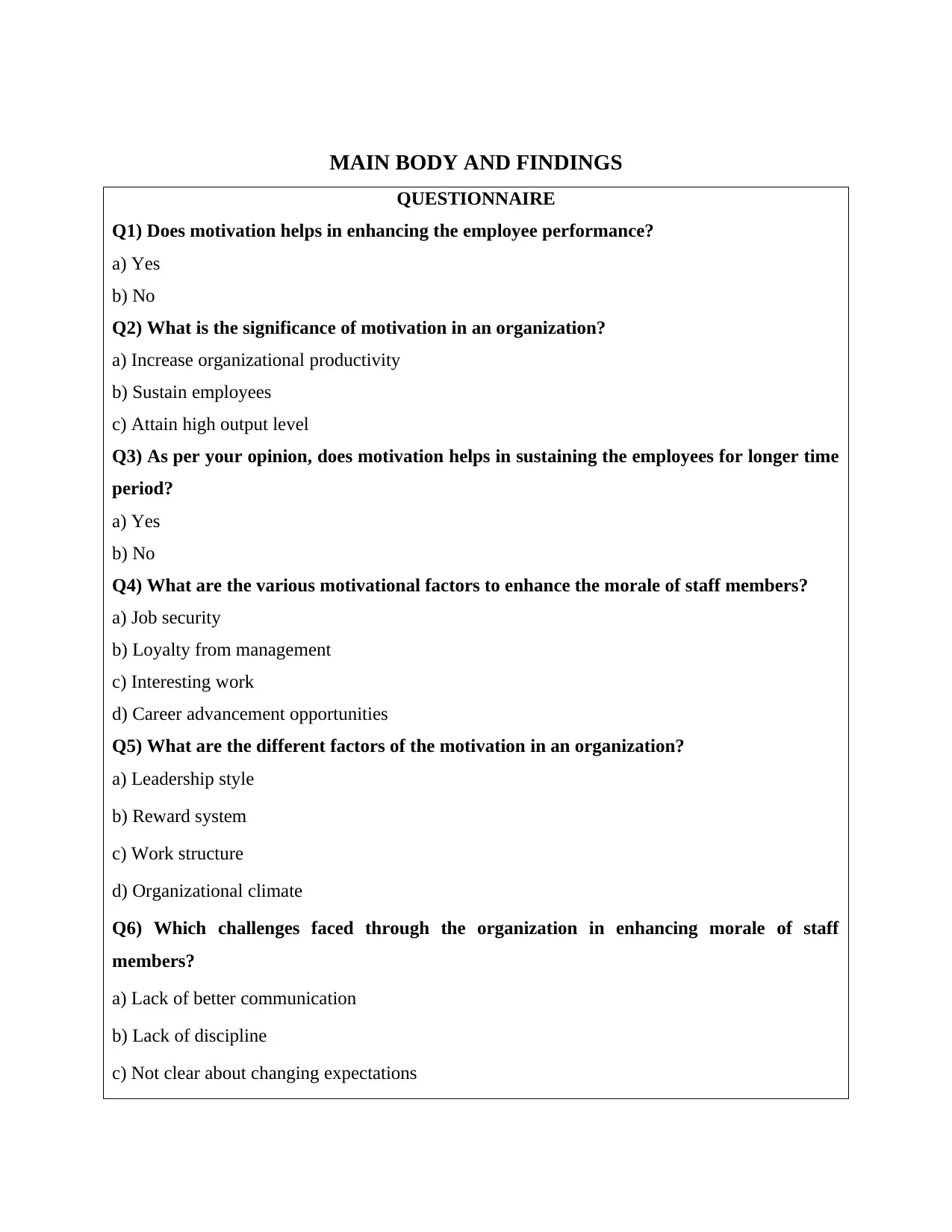
MAIN BODY AND FINDINGS
QUESTIONNAIRE
Q1) Does motivation helps in enhancing the employee performance?
a) Yes
b) No
Q2) What is the significance of motivation in an organization?
a) Increase organizational productivity
b) Sustain employees
c) Attain high output level
Q3) As per your opinion, does motivation helps in sustaining the employees for longer time
period?
a) Yes
b) No
Q4) What are the various motivational factors to enhance the morale of staff members?
a) Job security
b) Loyalty from management
c) Interesting work
d) Career advancement opportunities
Q5) What are the different factors of the motivation in an organization?
a) Leadership style
b) Reward system
c) Work structure
d) Organizational climate
Q6) Which challenges faced through the organization in enhancing morale of staff
members?
a) Lack of better communication
b) Lack of discipline
c) Not clear about changing expectations
QUESTIONNAIRE
Q1) Does motivation helps in enhancing the employee performance?
a) Yes
b) No
Q2) What is the significance of motivation in an organization?
a) Increase organizational productivity
b) Sustain employees
c) Attain high output level
Q3) As per your opinion, does motivation helps in sustaining the employees for longer time
period?
a) Yes
b) No
Q4) What are the various motivational factors to enhance the morale of staff members?
a) Job security
b) Loyalty from management
c) Interesting work
d) Career advancement opportunities
Q5) What are the different factors of the motivation in an organization?
a) Leadership style
b) Reward system
c) Work structure
d) Organizational climate
Q6) Which challenges faced through the organization in enhancing morale of staff
members?
a) Lack of better communication
b) Lack of discipline
c) Not clear about changing expectations
⊘ This is a preview!⊘
Do you want full access?
Subscribe today to unlock all pages.

Trusted by 1+ million students worldwide
1 out of 28
Related Documents
Your All-in-One AI-Powered Toolkit for Academic Success.
+13062052269
info@desklib.com
Available 24*7 on WhatsApp / Email
![[object Object]](/_next/static/media/star-bottom.7253800d.svg)
Unlock your academic potential
Copyright © 2020–2025 A2Z Services. All Rights Reserved. Developed and managed by ZUCOL.





